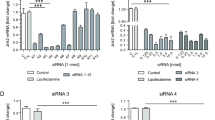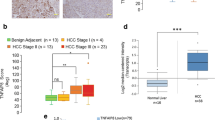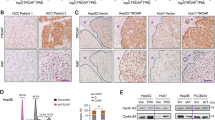Abstract
As hepatocellular carcinoma (HCC) is one of the most common tumors worldwide, development of novel therapeutic approaches for HCC is urgently needed. Two different genes, LETM1 and CTMP, which target mitochondrial functions, were chosen and linked using 2A-peptide sequence. Successful self-cleavage of 2A-peptide induced synergistic antitumor effect in the liver of H-ras12V, the HCC model mice, by simultaneous activation of LETM1 (Leucine zipper/EF hand-containing transmembrane-1) and CTMP (carboxyl-terminal modulator protein). Overexpression of LETM1 and CTMP significantly reduced the incidence of tumorigenesis, which were confirmed by gross and microscopic observations. Morphological changes in mitochondria, such as swelling and loss of cristae, were significant, and the prolonged activation of defects in mitochondrial function led to mitochondria-mediated apoptosis. Furthermore, with CTMP as a direct binding partner of Akt1, and LETM1 as a binding partner of CTMP, LETM1-2A-CTMP downregulated the Akt1 pathway at both Ser473 and Thr308 sites of phosphorylation. Proliferation and angiogenesis, which are important in cancer prognosis, were reduced in tumor sites after introduction of LETM1-2A-CTMP. Taken together, the results indicate that introduction of the mitochondria-targeting genes, LETM1 and CTMP, and self-processing capacity of 2A-peptide sequence exerts an antitumor effect in liver of H-ras12V mice, suggesting its potential as a tool for gene therapy.
This is a preview of subscription content, access via your institution
Access options
Subscribe to this journal
Receive 12 print issues and online access
$259.00 per year
only $21.58 per issue
Buy this article
- Purchase on Springer Link
- Instant access to full article PDF
Prices may be subject to local taxes which are calculated during checkout






Similar content being viewed by others
References
Thun MJ, DeLancey JO, Center MM, Jemal A, Ward EM . The global burden of cancer: priorities for prevention. Carcinogenesis 2010; 31: 100–110.
Kota J, Chivukula RR, O'Donnell KA, Wentzel EA, Montgomery CL, Hwang HW et al. Therapeutic microRNA delivery suppresses tumorigenesis in a murine liver cancer model. Cell 2009; 137: 1005–1017.
Young JL, Dean DA . Nonviral gene transfer strategies for the vasculature. Microcirculation 2002; 9: 35–50.
Kim JH, Minai-Tehrani A, Kim YK, Shin JY, Hong SH, Kim HJ et al. Suppression of tumor growth in H-ras12V liver cancer mice by delivery of programmed cell death protein 4 using galactosylated poly (ethylene glycol)-chitosan-graft-spermine. Biomaterials 2012; 33: 1894–1902.
Fang J, Qian JJ, Yi S, Harding TC, Tu GH, VanRoey M et al. Stable antibody expression at therapeutic levels using the 2A peptide. Nat Biotechnol 2005; 23: 584–590.
Szymczak AL, Vignali DAA . Development of 2A peptide-based strategies in the design of multicistronic vectors. Expert Opin Biol Ther 2005; 5: 627–638.
Armstrong JS . Mitochondria: a target for cancer therapy. Br J Pharmacol 2006; 147: 239–248.
Decaudin D, Marzo I, Brenner C, Kroemer G . Mitochondria in chemotherapy-induced apoptosis: a prospective novel target of cancer therapy (review). Int J Oncol 1998; 12: 141–152.
Fulda S, Galluzzi L, Kroemer G . Targeting mitochondria for cancer therapy. Nat Rev Drug Discov 2010; 9: 447–464.
Gogvadze V, Orrenius S, Zhivotovsky B . Mitochondria in cancer cells: what is so special about them? Trends Cell Biol 2008; 18: 165–173.
Newmeyer DD, Ferguson-Miller S . Mitochondria: releasing power for life and unleashing the machineries of death. Cell 2003; 112: 481–490.
Suen DF, Norris KL, Youle RJ . Mitochondrial dynamics and apoptosis. Genes Dev 2008; 22: 1577–1590.
Dimmer KS, Navoni F, Casarin A, Trevisson E, Endele S, Winterpacht A et al. LETM1, deleted in Wolf–Hirschhorn syndrome is required for normal mitochondrial morphology and cellular viability. Hum Mol Genet 2008; 17: 201–214.
Hwang SK, Piao L, Lim HT, Minai-Tehrani A, Yu KN, Ha YC et al. Suppression of lung tumorigenesis by leucine zipper/EF hand–containing transmembrane-1. PLoS ONE 2010; 5: e12535.
Maira SM, Galetic I, Brazil DP, Kaech S, Ingley E, Thelen M et al. Carboxyl-terminal modulator protein (CTMP), a negative regulator of PKB/Akt and v-Akt at the plasma membrane. Science 2001; 294: 374–380.
Piao L, Li Y, Kim SJ, Sohn KC, Yang KJ, Park KA et al. Regulation of OPA1-mediated mitochondrial fusion by leucine zipper/EF-hand-containing transmembrane protein-1 plays a role in apoptosis. Cell Signal 2009; 21: 767–777.
Hwang S, Kwon J, Park S, Chang S, Lee E, Chung Y et al. Lentivirus-mediated carboxyl-terminal modulator protein gene transfection via aerosol in lungs of K-ras null mice. Gene Ther 2007; 14: 1721–1730.
Hwang S, Minai-Tehrani A, Yu K, Chang S, Kim J, Lee K et al. Carboxyl-terminal modulator protein induces apoptosis by regulating mitochondrial function in lung cancer cells. Int J Oncol 2011; 40: 1515–1524.
Hwang SK, Lim HT, Minai-Tehrani A, Lee ES, Park J, Park SB et al. Repeated aerosol delivery of carboxyl-terminal modulator protein suppresses tumor in the lungs of K-rasLA1 mice. Am J Respir Crit Care Med 2009; 179: 1131–1140.
Wang AG, Moon HB, Lee MR, Hwang CY, Kwon KS, Yu SL et al. Gender-dependent hepatic alterations in H-ras12V transgenic mice. J Hepatol 2005; 43: 836–844.
Trichas G, Begbie J, Srinivas S . Use of the viral 2A peptide for bicistronic expression in transgenic mice. BMC Biol 2008; 6: 40.
Deng W, Yang D, Zhao B, Ouyang Z, Song J, Fan N et al. Use of the 2A peptide for generation of multi-transgenic pigs through a single round of nuclear transfer. PLoS ONE 2011; 6: e19986.
Hunter T . Oncoprotein networks. Cell 1997; 88: 333–346.
McLachlin JR, Mittereder N, Daucher MB, Kadan M, Eglitis MA . Factors affecting retroviral vector function and structural integrity. Virology 1993; 195: 1–5.
Xu L, Yee JK, Wolff J, Friedmann T . Factors affecting long-term stability of Moloney murine leukemia virus-based vectors. Virology 1989; 171: 331–341.
Gu M, Cooper J, Taanman J, Schapira A . Mitochondrial DNA transmission of the mitochondrial defect in Parkinson's disease. Ann Neurol 1998; 44: 177–186.
Schapira A, Cooper J, Dexter D, Clark J, Jenner P, Marsden C . Mitochondrial complex I deficiency in Parkinson's disease. J Neurochem 1990; 54: 823–827.
Brandon M, Baldi P, Wallace D . Mitochondrial mutations in cancer. Oncogene 2006; 25: 4647–4662.
Carew JS, Huang P . Mitochondrial defects in cancer. Mol Cancer 2002; 1: 9.
Chatterjee A, Mambo E, Sidransky D . Mitochondrial DNA mutations in human cancer. Oncogene 2006; 25: 4663–4674.
Parcellier A, Tintignac LA, Zhuravleva E, Cron P, Schenk S, Bozulic L et al. Carboxy-terminal modulator protein (CTMP) is a mitochondrial protein that sensitizes cells to apoptosis. Cell Signal 2009; 21: 639–650.
Marzo I, Brenner C, Zamzami N, Jürgensmeier JM, Susin SA, Vieira HLA et al. Bax and adenine nucleotide translocator cooperate in the mitochondrial control of apoptosis. Science 1998; 281: 2027–2031.
Wolter KG, Hsu YT, Smith CL, Nechushtan A, Xi XG, Youle RJ . Movement of Bax from the cytosol to mitochondria during apoptosis. J Cell Biol 1997; 139: 1281–1292.
Li P, Nijhawan D, Budihardjo I, Srinivasula SM, Ahmad M, Alnemri ES et al. Cytochrome c and dATP-dependent formation of Apaf-1/caspase-9 complex initiates an apoptotic protease cascade. Cell 1997; 91: 479–489.
Perkins CL, Fang G, Kim CN, Bhalla KN . The role of Apaf-1, caspase-9, and bid proteins in etoposide- or paclitaxel-induced mitochondrial events during apoptosis. Cancer Res 2000; 60: 1645–1653.
Gwinn DM, Shackelford DB, Egan DF, Mihaylova MM, Mery A, Vasquez DS et al. AMPK phosphorylation of raptor mediates a metabolic checkpoint. Mol Cell 2008; 30: 214–226.
Xiang X, Saha AK, Wen R, Ruderman NB, Luo Z . AMP-activated protein kinase activators can inhibit the growth of prostate cancer cells by multiple mechanisms. Biochem Biophys Res Commun 2004; 321: 161–167.
Motoshima H, Goldstein BJ, Igata M, Araki E . AMPK and cell proliferation–AMPK as a therapeutic target for atherosclerosis and cancer. J Physiol 2006; 574: 63–71.
Fleischer B, Schulze-Bergkamen H, Schuchmann M, Weber A, Biesterfeld S, Müller M et al. Mcl-1 is an anti-apoptotic factor for human hepatocellular carcinoma. Int J Oncol 2006; 28: 25–32.
Miller DW, Graulich W, Karges B, Stahl S, Ernst M, Ramaswamy A et al. Elevated expression of endoglin, a component of the TGF‐β‐receptor complex, correlates with proliferation of tumor endothelial cells. Int J Cancer 1999; 81: 568–572.
Wong AK, Alfert M, Castrillon DH, Shen Q, Holash J, Yancopoulos GD et al. Excessive tumor-elaborated VEGF and its neutralization define a lethal paraneoplastic syndrome. Proc Natl Acad Sci USA 2001; 98: 7481–7486.
Niu G, Wright KL, Huang M, Song L, Haura E, Turkson J et al. Constitutive Stat3 activity up-regulates VEGF expression and tumor angiogenesis. Oncogene 2002; 21: 2000–2008.
Seghezzi G, Patel S, Ren CJ, Gualandris A, Pintucci G, Robbins ES et al. Fibroblast growth factor-2 (FGF-2) induces vascular endothelial growth factor (VEGF) expression in the endothelial cells of forming capillaries: an autocrine mechanism contributing to angiogenesis. J Cell Biol 1998; 141: 1659–1673.
Plum SM, Holaday JW, Ruiz A, Madsen JW, Fogler WE, Fortier AH . Administration of a liposomal FGF-2 peptide vaccine leads to abrogation of FGF-2-mediated angiogenesis and tumor development. Vaccine 2000; 19: 1294–1303.
Acknowledgements
This work was supported by National Research Foundation grant funded by the Korea government (MEST) (No. 2012M3A9B6055304) and partially supported by the Research Institute for Veterinary Science, Seoul National University.
Disclaimer
The funders had no role in the study design, data collection or analysis, decision to publish or preparation of the manuscript.
Author information
Authors and Affiliations
Corresponding author
Ethics declarations
Competing interests
The authors declare no conflict of interest.
Additional information
Supplementary Information accompanies the paper on Cancer Gene Therapy website
Rights and permissions
About this article
Cite this article
Shin, JY., Chung, YS., Kang, B. et al. Co-delivery of LETM1 and CTMP synergistically inhibits tumor growth in H-ras12V liver cancer model mice. Cancer Gene Ther 20, 186–194 (2013). https://doi.org/10.1038/cgt.2013.6
Received:
Revised:
Accepted:
Published:
Issue Date:
DOI: https://doi.org/10.1038/cgt.2013.6



